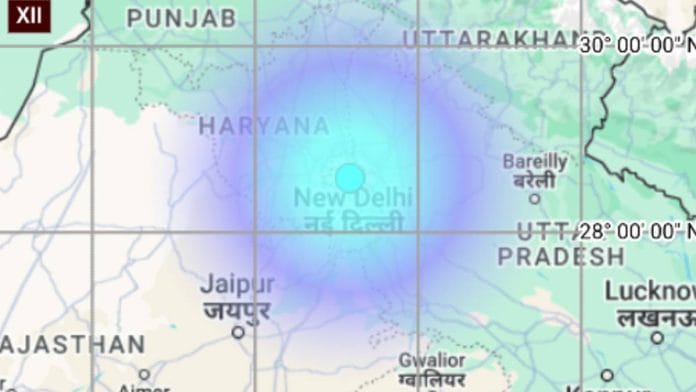New Delhi: After the initial panic when Delhiites were awakened by jolts, a loud boom and buildings shaking at 5.36 am Monday, they were surprised to learn that the earthquake that shook the city and adjoining areas was just a moderate 4 in magnitude on the Richter scale.
It felt much stronger than previous ones that have shaken the city.
ThePrint explains what caused Monday’s quake to feel significantly stronger than recorded on the Richter scale, and what caused the loud boom.
Moderate in magnitude
Hours after Delhi’s early morning scare, Bihar experienced tremors around 8.02 am. The magnitude of this quake was also 4, and its depth was about 10 km. But people in Bihar didn’t experience it with the same intensity as Delhi residents.
“That’s because the epicentre of the earthquake was in Delhi—more precisely, south Delhi’s Jheel Park,” O.P. Mishra, director of the National Center for Seismology, told ThePrint. With a shallow depth of just 5 kilometres under Delhi, it was felt more prominently.
Shallow earthquakes are seismic events that occur near the Earth’s surface, typically at depths of less than 50 km.
According to experts, in the worst case, these earthquakes are known for their potential to cause significant destruction, often surpassing the impact of deeper ones. But Delhi was fortunate, in that the damage was minimal with no loss to life.
“Seismologically, Delhi is not a new region. Earlier (in 2007), there was a 4.6 magnitude earthquake in the 6 km periphery (of Delhi), but it was deeper, with 10 km depth,” said Mishra.
He explained that Monday’s quake was different from more recent ones recorded in the region because it was not the usual plate tectonics earthquake but was caused by “in situ material heterogeneity”.
This means that it occurred due to variations in geological features in the region as opposed to those caused by sudden movements in the Earth’s crust.
“Aftershocks—of around one or 1.2 magnitude—to this quake can be expected in the coming days,” he added.
In 2022, a shallow earthquake of magnitude 5.6 had caused major damage in Indonesia, killing at least 160, injuring hundreds and leaving a devastating impact on property.
What was the loud boom?
An earthquake below 2.5 magnitude is considered “mild” and does not cause tremors. A quake with magnitude between 2.5 and 5.4 is marked “moderate”, causing minor tremors, and only those above 5.4 are considered “severe” earthquakes, which have the potential to cause strong tremors and damage.
Small shallow earthquakes sometimes produce rumbling sounds or booms that can be heard by people, according to the US Geological Survey (USGS).
“High-frequency vibrations from the shallow earthquake generate the booming sound; when earthquakes are deeper, those vibrations never reach the surface. Sometimes, earthquakes create booming sounds even when no vibrations are felt,” the USGS website reads.
(Edited by Nida Fatima Siddiqui)
Also Read: Mapping earth’s heartbeat every second—a day at National Centre for Seismology






